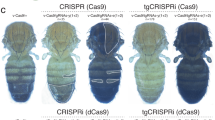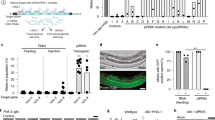Abstract
The first evidence for gene disruption by double-stranded RNA (dsRNA) came from careful analysis in Caenorhabditis elegans1. This phenomenon, called RNA interference (RNAi), was observed subsequently in various organisms, including plants, nematodes, Drosophila, and protozoans2,3,4,5. Very recently, it has been reported that in mammalian cells, 21- or 22-nucleotide (nt) RNAs with 2-nt 3′ overhangs (small inhibitory RNAs, siRNAs) exhibit an RNAi effect6,7. This is because siRNAs are not recognized by the well-characterized host defense system against viral infections, involving dsRNA-dependent inhibition of protein synthesis. However, the current method for introducing synthetic siRNA into cells by lipofection restricts the range of applications of RNAi as a result of the low transfection efficiencies in some cell types and/or short-term persistence of silencing effects8. Here, we report a vector-based siRNA expression system that can induce RNAi in mammalian cells. This technical advance for silencing gene expression not only facilitates a wide range of functional analysis of mammalian genes but might also allow therapeutic applications by means of vector-mediated RNAi.
This is a preview of subscription content, access via your institution
Access options
Subscribe to this journal
Receive 12 print issues and online access
$209.00 per year
only $17.42 per issue
Buy this article
- Purchase on Springer Link
- Instant access to full article PDF
Prices may be subject to local taxes which are calculated during checkout



Similar content being viewed by others
References
Fire, A. et al. Potent and specific genetic interference by double-stranded RNA in Caenorhabditis elegans. Nature 391, 806–811 (1998).
Fire, A. RNA-triggered gene silencing. Trends Genet. 15, 358–363 (1999).
Sharp, P.A. RNA interference 2001. Genes Dev. 15, 485–490 (2001).
Hammond, S.M., Caudy, A.A. & Hannon, G.J. Post-transcriptional gene silencing by double-stranded RNA. Nature Rev. Genet. 2, 110–119 (2001).
Zamore, P.A. RNA interference: listening to the sound of silence. Nat. Struct. Biol. 8, 746–750 (2001).
Elbashir, S.M. et al. Duplexes of 21-nucleotide RNAs mediate RNA interference in cultured mammalian cells. Nature 411, 494–498 (2001).
Caplen, N.J., Parrish, S., Imani, F., Fire, A. & Morgan, R.A. Specific inhibition of gene expression by small double-stranded RNAs in invertebrate and vertebrate systems. Proc. Natl. Acad. Sci. USA 98, 9742–9747 (2001).
Yang, S., Tutton, S., Pierce, E. & Yoon, K. Specific double-stranded RNA interference in undifferentiated mouse embryonic stem cells. Mol. Cell Biol. 21, 7807–7816 (2001).
Paule, M.R. & White, R.J. Survey and summary: transcription by RNA polymerases I and III. Nucleic Acids Res. 28, 1283–1298 (2000).
Bogenhagen, D.F. & Brown, D.D. Nucleotide sequences in Xenopus 5S DNA required for transcription termination. Cell 24, 261–270 (1981).
Warashina, M., Kuwabara, T., Kato, Y., Sano, M. & Taira, K. RNA–protein hybrid ribozymes that efficiently cleave any mRNA independently of the structure of the target RNA. Proc. Natl. Acad. Sci. USA 98, 5572–5577 (2001).
Elbashir, S.M., Martinez, J., Patkaniowska, A., Lendeckel, W. & Tuschl, T. Functional anatomy of siRNAs for mediating efficient RNAi in Drosophila melanogaster embryo lysate. EMBO J. 20, 6877–6888 (2001).
Peifer, M. & Polakis, P. Wnt signaling in oncogenesis and embryogenesis—a look outside the nucleus. Science 287, 1606–1609 (2000).
Chittenden, T., Lupton, S. & Levine, A.J. Functional limits of oriP, the Epstein–Barr virus plasmid origin of replication. J. Virol. 63, 3016–3025 (1989).
Ohkawa, J. & Taira, K. Control of the functional activity of an antisense RNA by a tetracycline-responsive derivative of the human U6 snRNA promoter. Hum Gene Ther. 11, 577–585 (2000).
Akashi, H., Miyagishi, M. & Taira, K. Suppression of gene expression by RNA interference in cultured plant cells. Antisense Nucleic Acid Drug Dev. 11, 359–367 (2001).
Wang, Z., Morris, J.C., Drew, M.E. & Englund, P.T. Inhibition of Trypanosoma brucei gene expression by RNA interference using an integratable vector with opposing T7 promoters. J. Biol. Chem. 275, 40174–40179 (2000).
Kawasaki, H., Onuki, R., Suyama, E. & Taira, K. Identification of genes that function in the TNF-α-mediated pathway to apoptosis by analysis of randomized hybrid-ribozyme libraries. Nat. Biotechnol. 20, 376–380 (2002).
Kawasaki, H. & Taira, K. Identification of genes by hybrid ribozymes that couple cleavage activity with the unwinding activity of an endogenous RNA helicase. EMBO Rep. (in press).
Miyagishi, M. et al. Regulation of Lef-mediated transcription and p53-dependent pathway by associating β-catenin with CBP/p300. J. Biol. Chem. 275, 35170–35175 (2000).
Acknowledgements
This research was supported by a Grant-in-Aid for Scientific Research from the Ministry of Education, Culture, Sports, Science and Technology (MEXT) of Japan, and grants from the Ministry of Economy, Trade and Industry (METI) of Japan.
Author information
Authors and Affiliations
Corresponding author
Ethics declarations
Competing interests
The authors declare no competing financial interests.
Rights and permissions
About this article
Cite this article
Miyagishi, M., Taira, K. U6 promoter–driven siRNAs with four uridine 3′ overhangs efficiently suppress targeted gene expression in mammalian cells. Nat Biotechnol 20, 497–500 (2002). https://doi.org/10.1038/nbt0502-497
Received:
Accepted:
Issue Date:
DOI: https://doi.org/10.1038/nbt0502-497
This article is cited by
-
A novel vector-based RNAi method using mouse U6 promoter-driven shRNA expression in the filamentous fungus Blakeslea trispora
Biotechnology Letters (2021)
-
In Vivo Gene Silencing of Potato Virus X by Small Interference RNAs in Transgenic Potato
Potato Research (2020)
-
A T7 autogene-based hybrid mRNA/DNA system for long-term shRNA expression in cytoplasm without inefficient nuclear entry
Scientific Reports (2019)
-
Super-Mendelian inheritance mediated by CRISPR–Cas9 in the female mouse germline
Nature (2019)
-
CRISPR/Cas9 genome editing technology in filamentous fungi: progress and perspective
Applied Microbiology and Biotechnology (2019)



